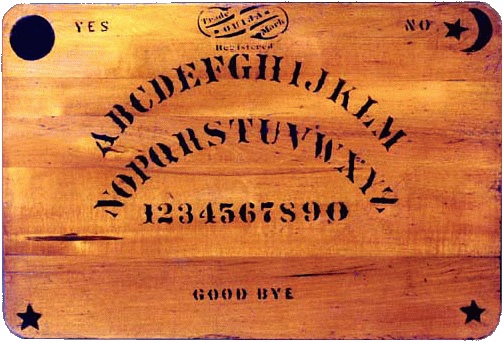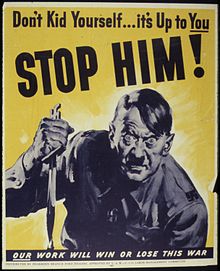OUIJA BOARDS
The Ouija board (pron.: /ˈwiːdʒə/ wee-jə) also known as a spirit board or talking board, is a flat board marked with the letters of the alphabet, the numbers 0-9, the words "yes", "no", "hello" (occasionally), and "goodbye", along with various symbols and graphics. It is a registered trademark ofHasbro Inc.,[1] which markets and distributes the Ouija Board as part of its line of board games.[2] It uses a planchette (small heart-shaped piece of wood) or movable indicator to indicate the spirit's message by spelling it out on the board during a séance. Participants place their fingers on the planchette and it is moved about the board to spell out words. It has become a trademark that is often used generically to refer to any talking board.
Following its commercial introduction by businessman Elijah Bond on July 1, 1890,[3] the Ouija board was regarded as a harmless parlor game unrelated to the occult until American Spiritualist Pearl Curran popularized its use as a divining tool during World War I.[4]
Mainstream religions and some occultists have associated use of a Ouija board with the concept of demonic possession, and view the use of the board as a spiritual threat and have cautioned their followers not to use an Ouija board.[5]
While Ouija believers feel the paranormal or supernatural are responsible for Ouija's action, it is parsimoniously explained by unconscious movements of those controlling the pointer, a psychophysiological phenomenon known as the ideomotor effect.[6][7][8] Despite being harshly criticized by the scientific community and deemed superstitious by traditional Christians, Ouija remains popular among many people.[4]

History
[edit]China
See also: Fuji (planchette writing)
One of the first mentions of the automatic writing method used in the Ouija board is found in China around 1100 AD, in historical documents of the Song Dynasty. The method was known as fuji (扶乩), "planchette writing". The use of planchette writing as an ostensible means of contacting the dead and the spirit-world continued, and, albeit under special rituals and supervisions, was a central practice of the Quanzhen School, until it was forbidden by theQing Dynasty.[9] Several entire scriptures of the Daozang are supposedly works of automatic planchette writing. Similar methods of mediumistic spirit writing have been widely practiced in ancient India, Greece, Rome, and medieval Europe.[10]
[edit]Toy
During the late 19th century, planchettes were widely sold as a novelty. The businessmen Elijah Bond and Charles Kennard had the idea to patent aplanchette sold with a board on which the alphabet was printed. The patentees filed on May 28, 1890 for patent protection and thus had invented the first Ouija board. Issue date on the patent was February 10, 1891. They received U.S. Patent 446,054. Bond was an attorney and was an inventor of other objects in addition to this device. An employee of Kennard, William Fuld took over the talking board production and in 1901, he started production of his own boards under the name "Ouija".[11] Kennard claimed he learned the name "Ouija" from using the board and that it was an ancient Egyptian word meaning "good luck." When Fuld took over production of the boards, he popularized the more widely accepted etymology, that the name came from a combination of the French and German words for "yes".[12] The Fuld name would become synonymous with the Ouija board, as Fuld reinvented its history, claiming that he himself had invented it. The strange talk about the boards from Fuld's competitors flooded the market, and all these boards enjoyed a heyday from the 1920s through the 1960s. Fuld sued many companies over the "Ouija" name and concept right up until his death in 1927. In 1966, Fuld's estate sold the entire business to Parker Brothers, which was sold to Hasbro in 1991, and which continues to hold all trademarks and patents. About ten brands of talking boards are sold today under various names.[11]
[edit]Criticism
[edit]Religious
Most religious criticism of the Ouija board has come from Christians, primarily evangelicals in the United States. In 2001, Ouija boards were burned inAlamogordo, New Mexico by fundamentalist groups alongside Harry Potter books as "symbols of witchcraft."[13][14][15] Religious criticism has also expressed beliefs that the Ouija board reveals information which should only be on God's hands, and thus it is a tool of Satan.[16] A spokesperson for Human Life International described the boards as a portal to talk to spirits and called for Hasbro to be prohibited from marketing them.[17]
Bishops in Micronesia called for the boards to be banned and warned congregations that they were talking to demons and devils when using the boards.[18]
[edit]Popular
Ouija boards have been criticized in the press since their inception; having been variously described as "'vestigial remains' of primitive belief-systems" and a con to part fools from their money.[19][20] Some journalists have described reports of Ouija board findings as 'half truths' and have suggested that their inclusion in national newspapers lowers the national discourse overall.[21]
[edit]Academic
The Ouija phenomenon has been criticized by many scientists as a hoax related to the ideomotor response.[22] Various studies have been produced, recreating the effects of the Ouija board in the lab and showing that, at least under laboratory conditions, the subjects were moving the planchette involuntarily.[22][23] Detractors have described Ouija board users as 'operators'.[24] Some critics noted that the messages ostensibly spelled out by spirits were similar to whatever was going through the minds of the subjects.[25]
In the 1970s Ouija board users were also described as "cult members" by sociologists, though this was severely scrutinised in the field.[26]
[edit]Use in creation of literature
Ouija boards have been the source of inspiration for literary works, used as guidance in writing, or as a form of channeling literary works. As a result of Ouija boards becoming popular in the early 20th century, by the 1920s many "psychic" books were written of varying quality often initiated by Ouija board use.[27]
Emily Grant Hutchings claimed that her 1917 novel Jap Herron: A Novel Written from the Ouija Board was dictated by Mark Twain's spirit through the use of a Ouija board after his death.[28]
Poems and novels written by Patience Worth, an alleged spirit, contacted by Pearl Lenore Curran, for more than 20 years, were initially transcribed from sessions with a Ouija board.
In 1982, poet James Merrill released an apocalyptic 560-page epic poem entitled The Changing Light at Sandover, which documented two decades of messages dictated from the Ouija board during séances hosted by Merrill and his partner David Noyes Jackson. Sandover, which received the National Book Critics Circle Award in 1983,[29] was published in three volumes beginning in 1976. The first contained a poem for each of the letters A through Z, and was called The Book of Ephraim. It appeared in the collection Divine Comedies, which won the Pulitzer Prize for Poetry in 1977.[30] According to Merrill, the spirits ordered him to write and publish the next two installments, Mirabell: Books of Number in 1978 (which won the National Book Award for Poetry)[31] andScripts for the Pageant in 1980.
The 1991 horror novel Darkness, Tell Us by multi-award winner Richard Laymon was also based on Ouija boards.
[edit]Notable users
Much of William Butler Yeats' later poetry was inspired, among other facets of occultism, by the Ouija board. Yeats himself did not use it but his wife did.[32]
G. K. Chesterton used a Ouija board in his teenage years. Around 1893 he had gone through a crisis of scepticism and depression, and during this period Chesterton experimented with the Ouija board and grew fascinated with the occult.[33]
Poet James Merrill used a Ouija board for years and even encouraged entrance of spirits into his body. Before he died, he recommended that people not use Ouija boards.[34]
Former Italian Prime Minister Romano Prodi claimed under oath that, in a séance held in 1978 with other professors at the University of Bologna, the "ghost" of Giorgio La Pira spelled the name of the street where Aldo Moro was being held by the Red Brigades in a Ouija. According to Peter Popham of The Independent: "Everybody here has long believed that Prodi's Ouija board tale was no more than an ill-advised and bizarre way to conceal the identity of his true source, probably a person from Bologna's seething far-left underground whom he was pledged to protect."[35]
In London in 1994, convicted murderer Stephen Young was granted a retrial after it was learned that four of the jurors had conducted a Ouija board seance and had "contacted" the murdered man, who had named Young as his killer.[36] Young was convicted for a second time at his retrial and jailed for life.[37][38][39]
Bill Wilson, the co-founder of Alcoholics Anonymous, used a Ouija board and conducted seances in attempts to contact the dead.[40]
On the July 25, 2007 edition of the paranormal radio show Coast to Coast AM, host George Noory attempted to carry out a live Ouija board experiment on national radio despite the strong objections of one of his guests, Jordan Maxwell, and with the encouragement of his other guests, Dr. Bruce Goldberg, Rosemary Ellen Guiley, and Jerry Edward Cornelius.[citation needed] In the days and hours leading up to the show, unfortunate events kept occurring to Noory's friends and family as well as some of his guests, but these events would likely be considered coincidences. After recounting a near-death experience in 2000 and noting bizarre events taking place, Noory canceled the experiment.[41]
Dick Brooks of the Houdini Museum in Scranton, Pennsylvania, uses a Ouija board as part of a paranormal and seance presentation.[42]
The Mars Volta wrote their album Bedlam in Goliath based on their alleged experiences with a Ouija board. According to their story (written for them by a fiction author, Jeremy Robert Johnson),Omar Rodriguez Lopez purchased a Ouija board while traveling in Jerusalem. At first the board provided a story which became the theme for the album. Strange events allegedly related to this activity occurred during the recording of the album: the studio flooded, one of the album's main engineers had a nervous breakdown, equipment began to malfunction, and Cedric Bixler-Zavala's foot was injured. Following these bad experiences the band buried the Ouija board.[43]
Early press releases stated that Vincent Furnier's stage and band name "Alice Cooper" was agreed upon after a session with a Ouija board, during which it was revealed that Furnier was the reincarnation of a 17th century witch with that name. Alice Cooper later revealed that he just thought of the first name that came to his head while discussing a new band name with his band.[44]




